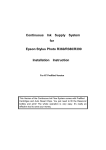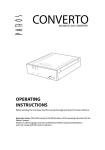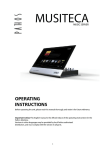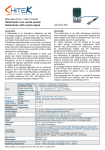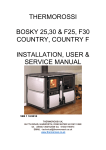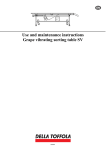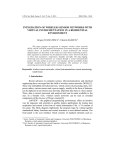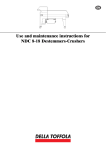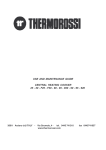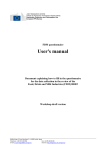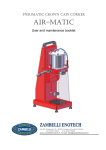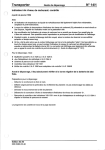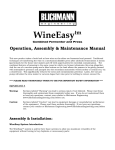Download GENERAL INSTRUCTIONS
Transcript
GENERAL INSTRUCTIONS Our pneumatic presses are manufactured entirely in AISI 304 stainless steel, mounted on wheels equipped with brake and the components are all high quality. Presses are composed of a rotary drum, an inner membrane fixed to the side of the drum, and are provided with one or more sliding doors for loading, draining and unloading the product; they have an axial load valve and are also provided with a trolley-mounted collection tank. The product is drained through inner channels and perforated doors. On request we can also supply presses with perforated drums. The differences between the various models mainly consist in different load capacities. PnZeta are reliable, simple to operate machines; nonetheless, they must be used with care and with a good knowledge of the machine. It is therefore advisable for the press to be used by one operator, who should read this manual carefully in order to make the best use of the potentials of the machine and also to avoid any damage to objects or injury to people. The Manufacturer declines all responsibility for any direct or indirect injury to people or damage to objects due to failure to comply with the information provided in this manual. SAFETY STANDARDS FOR USE INSTRUCTIONS: use the press after having read this manual carefully; in the event of loss, the manual may be requested from: Nuova Zambelli Via Nazionale, 19 Vancimuglio 36040 Grumolo Delle Abbadesse (VI) ITALY. USING THE PRESS: • only authorized operators with suitable knowledge are permitted to use the press. • do not carry out any operations or adjustments not indicated in this manual. • during processing ensure the machine brake is on and do not move the press. ••• during some phases of processing the drum is under pressure; never open the loading hatch before this pressure has been removed. • the selector switch (B) and emergency mushroom button (G) are provided with safety key to ensure only the operator can use the press. • always check that the guards are positioned correctly before starting up the machine. • the guards protecting moving parts must not be removed while the machine is operating. • keep at a safe distance from the press during processing. • keep children and irresponsible people away from the machine. • in the event of faulty operation of the press contact the manufacturer. Before unloading the press, make sure the floor on which it is to be placed is level and capable of sustaining both the weight of the machine and of the product to be loaded. Also check that the means used for unloading are appropriate. LIFTING: the press must be lifted by connecting ropes to the four eyebolts (13) provided in the corners MOVEMENT: the press is mounted on four wheels provided with brakes to facilitate movement. Once the press has been positioned in the workplace, lock the wheels using the brakes provided. ELECTRICAL CONNECTION: • do not run over the cables with equipment or machinery that could damage them. • do not lay the power cables on wet or muddy ground. • switches, sockets and plugs must be protected from dampness. • the cables used must always be provided with earth wire and must have a suitable diameter. • do not make connections with temporary electric cables or those with an unsuitable diameter. • before starting up the machine check it is correctly earthed. ••• the electric system of the building must be provided with a thermal magnetic circuit breaker, to guarantee the safety of people in the event of a fault. ••• before making any connections always check the mains voltage corresponds to the voltage indicated on the press. ••• only start up the machine after having checked correct connection to the system. If the safety rope (16) is used, before restarting, the switch (25) must be reset and the start cycle button (H) pressed again. IDENTIFICATION OF MACHINE COMPONENTS Becker Compressor A. Master switch Solenoid Valve B. Manual and automatic operation selector switch Pressure switch operation selector switch Pressure switch XMGB091 C. Programme selector switch Pressure switch XMGB002 D. Right-left rotation selector Becker blower switch Gear motor E. Blower selector switch Crown gear F. Compressor pressure selector Pinion switch 0. Drive chain G. Emergency button 1. Switchboard H. Start cycle button 2. Collection tank I. Power pilot light 3. Eyebolt L. Press operation pilot light 4. Safety switch M. End of cycle pilot light 5. Loading door N. Thermal cut-out pilot light 6. Safety rope 7. Axial valve 8. Press wheels 9. Tank wheels 0. Press membrane 1. Drainage channel 2. Membrane bolts 3. Door lock 4. Press drum CONTENTS GENERAL INSTRUCTIONS IDENTIFICATION OF MACHINE COMPONENTS SAFETY STANDARDS FOR USE WORK PROGRAMMES SETTING AT WORK AND INSTRUCTIONS FOR USE NORMAL MAINTENANCE GENERAL CONDITIONS OF SALE GENERAL CONDITIONS OF SALE RANSPORT: to the charge of the purchaser. LAIMS: no claims shall be accepted after eight days of receiving the goods and no returns shall be accepted unless previously authorized by us and carriage free. Goods travel at the risk and peril of the customer. IMITATIONS: we shall not be responsible for breakages or damages caused by uses other than those for which the goods are designed. Faults and defects caused by wear of those parts which by nature are subject to wear are not included in the warranty, nor are returned parts that have been dismantled, tampered with or repaired outside our headquarters. WARRANTIES: our products are carefully tested, inspected and warranted. Our responsibility is limited to the replacement of any parts found defective after careful examination to be performed in our headquarters or at the Customer’s premises with charge for transport and labour costs. ISPUTES: disputes shall be settled by the Court of Vicenza. ECHNICAL DATA: technical data in this booklet are provided purely for information and are not binding. The manufacturer reserves the right to make modifications to the product without prior notice. WORK PROGRAMMES pnZeta PRESSES MAY BE OPERATED EITHER MANUALLY OR AUTOMATICALLY MANUAL OPERATION When turning the selector switch (B) to manual, the operator must use the selector switches (D - E - F) o perform operations. (D) (E) (F) Selector switch for right-left rotation Selector switch for pressure release and pressure Selector switch for working pressure With manual operation, the working pressure, the pressure times, the number of rotations and the work mes are at the discretion of the operator according to the type of product and its requirements. he operator can consult the automatic cycle table in the manual as a guide to operation. The press can only be operated manually at 0.6 and 1.5 bar. AUTOMATIC OPERATION When turning the selector switch (B) to automatic, the operator only requires to use the selector witches (H) and (C) to operate the press. (C) (H) Selector switch for programmes (1 - 2 - 3 - 4 - 5) Start cycle button (must be pressed and held for about 10 seconds so that the drum rotates with the hatch 15 facing downwards) here are 5 preset programmes on the selector switch (C) 1 - 2 for whole grapes 3 for fermented grapes 4 for destemmed or full-bodied grapes ach programme is composed of a series of cycles with different pressures and times. A work cycle comprises an operation to dilate the membrane, the pressure duration time, pressure release and the rotations. rogramme 1 comprises: 6 work cycles at 0.6 Bar 4 work cycles at 1.5 Bar the approximate processing time is 1h 20 min. rogramme 2 comprises: 3 work cycles at 0.6 Bar 6 work cycles at 1.5 Bar the approximate processing time is 1h 15 min. rogramme 3 comprises: 4 work cycles at 1.5 Bar the approximate processing time is 40 min. 4 work cycles at 0.26 Bar 4 work cycles at 0.6 Bar 4 work cycles at 1.5 Bar the approximate processing time is 1h 40 min. rogramme 4 comprises: rogramme 5 comprises: 6 work cycles at 0.26 Bar 4 work cycles at 0.6 Bar 4 work cycles at 1.5 Bar the approximate processing time is 2h 10 min. When the work programme has terminated, the end of cycle pilot light (M) comes on. SETTING AT WORK AND INSTRUCTIONS FOR USE fter carefully reading the instructions in the user manual, the operator can start work. he first thing to check is that the press rotates in the direction indicated on the selector switch (D) IGHT OR LEFT. If the press rotates to the right instead of to the left or vice versa, this means that the urrent phases are incorrect; the operator must switch off the machine immediately with the switch (A), emove the extension cable from the switchboard and invert the wires. Position the collection tank under the press and fit the pipe for delivering must to the tanks. WARNING: before loading the press make sure the membrane is totally deflated to prevent it from being damaged. MANUAL OPERATION OF THE PRESS Turn the switch (A) to position 1 to supply the press with power; the pilot light (I) will come on. Position the selector switch (B) to position 1 manual. Position the hatch (15) in the loading position using the selector switch (D) right or left. Turn off the switch (A) and fill the container with the product, then close the two doors locking them with the two door locks (23). Switch on the power supply using (A) and with the selector switch (D) turn the drum (24) to the position with the door facing downwards. Position the selector switch (E) to position 2 pressure. Position the selector switch (F) to position 1 pressure 0.6 bar. Upon reaching this pressure return the selector switch (F) to position 0 and wait a few minutes for the liquid to drain. Turn the selector switch (E) to position 1 pressure release until all the air has been emptied from the membrane. 0. After returning the selector switch (E) to position 0 rotate the drum using the selector switch (D) 5 times to the right and 5 times to the left and then stop it with the door (15) facing upwards. Repeat these operations 4 times at 0.6 bar. The subsequent operation will be the same but operating at a pressure of 1.5 bar, turning the selector switch (F) to position 2. 1. Repeat the operation 5 or 6 times at 1.5 bar. 2. When pressing has terminated use D to rotate the drum (24) so that the door (15) is facing upwards. 3. Switch off the master switch (A) and open the drum to check that pressing has been performed efficiently. 4. Then turn the drum with the door facing downwards and unload the pomace remaining after pressing. UTOMATIC OPERATION OF THE PRESS Before starting automatic operation, the selector switches (D) (E) (F) must be positioned to 0. he loading operation is as described above. Turn the selector (B) to position 2 automatic. Select the programme required using (C) (programme selector switch). Then press the button (H) to start the cycle and hold pressed for about 10 seconds; the drum (24) rotates by half a turn to take the door (15) to the lower draining position, release the button (H) and after about 2 seconds press H again to start the programme. During pressing the green pilot light (L) flashes. At the end of the programme the end of cycle pilot light (M) comes on. Now turn the selector switch (B) to position 1 manual and wait for about 10 seconds. Turn the selector switch (D) to rotate the drum (24) so that the door (15) is facing upwards. Switch off the master switch (A) and turn (D) to position 0. Open the cistern and check that pressing has been performed efficiently. Empty the press by switching on first (A), then turning (B) to manual position and (D) to position 1 or 2. 0. After emptying wash the press thoroughly. NORMAL MAINTENANCE Our presses must be cleaned thoroughly after utilization, must be stored in a dry place when not in use and must be covered carefully. Check the oil level in the gear motor and top up if necessary. Grease the drum chain and check tension. Check efficiency of the compressor and blower. MEMBRANE he inflatable membrane is produced in a material suitable for use with foods, is reliable and long sting. To maintain these characteristics it must be washed carefully in warm water, using alkaline olutions if necessary (diluted to 10%) and then rinsed thoroughly. ny pointed objects accidentally contained in the product to be pressed may perforate the membrane, hich however may be repaired rapidly. o replace the membrane loosen the membrane bolts (22), remove the old membrane, clean horoughly and apply a thread of silicone for use with foods before replacing the bolts.











